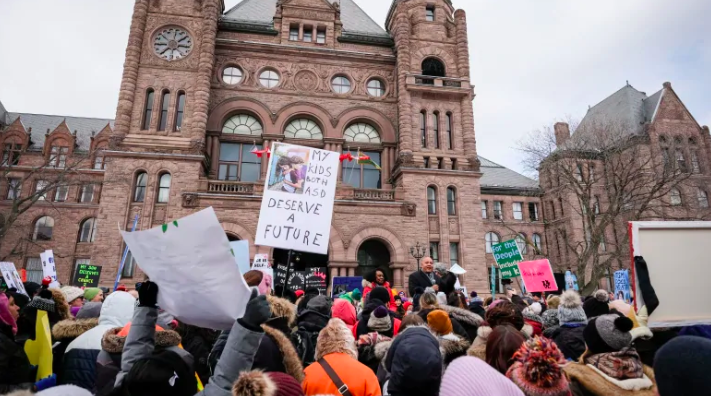Big changes are coming to Ontario’s autism program — here’s what you should know
The Progressive Conservative government’s recent changes to Ontario’s autism program have once again made the issue a political flash point.
The controversial revisions prompted exasperated parents to protest on the lawn at Queen’s Park in a scene reminiscent of just a few years ago, when many of the same people and groups demonstrated against a Liberal government over its own revamp of autism services.
The subject is complex and deeply emotional for those who know it intimately in their own lives, and many families are touched by it. One in 66 Canadian children is diagnosed with the neurological condition, the Public Health Agency of Canada reported in 2018, and according to Autism Ontario about 100,000 people in Ontario, including 40,000 children, are on the autism spectrum.
On February 6, Lisa MacLeod, the minister of children, community and social services, unveiled the expansive changes to the Ontario Autism Program at a news conference in Toronto. She said they were necessary to ensure that 23,000 children on the province’s therapy wait list would have access to necessary services within 18 months.
Many children, she added, were waiting more than two years to begin therapy. Further, MacLeod said the government would provide a one-time injection of $100-million that it said would keep the program running.
However, some parents have said the changes will reduce the total hours of therapy available to children, and cost families more money out of pocket.
In the weeks since the announcement, the autism program has dominated headlines and debates at question period. Many families, therapy providers and school administrators say they are unnerved and confused about what comes next.
CBC Toronto has answers to some common questions below:
What therapies exist for children with autism?
To unravel why changes to the Ontario Autism Program have stoked so much controversy, it’s important to understand the therapies that exist and how the program facilitates access to those treatments.
Autism is a “neurodevelopmental disorder with impairments in social communication and a pattern of repetitive stereotyped behaviours. Onset is early in childhood and the presentation changes with development over the life span,” according to a leading research agency.
It is experienced on a spectrum, and therefore there is no one-size-fits-all approach to treating those living with the condition. There are, however, evidence-based interventions that have proved effective in helping children with autism.
Applied Behavioural Analysis, commonly called ABA therapy, is the most widely used treatment. Repetition and positive reinforcement are used to help children learn skills they may not other pick up on their own. It’s usually done in a small setting, and ABA is most effective when children start it between two and five years old. In its most intense form, known as Intensive Behavioural Intervention (IBI), children interact one-on-one with a trained professional.
ABA can be very expensive, and it is not without controversy. However, the previous provincial government’s Ontario Autism Program was established to help families access and pay for ABA therapies.
What did the program look like under the previous government?
In March 2016, the previous Liberal government said it would invest $333 million over five years in an autism program that would integrate Intensive Behavioural Intervention and Applied Behavioural Analysis. Funding was to be based on an assessment of a child’s particular needs.
Initially, the Liberals said, only children between the ages of two and four years old would qualify for intensive therapies. After fierce push back from a coalition of parents and advocacy groups that included protests and a campaign called #Autismdoesntendat5, former premier Kathleen Wynne backtracked, eliminating the age cap, investing an additional $200 million and speeding up delivery by one year.
Funding was given to regional service providers who maintained waiting lists of families in need of financial support.
Once a child reached the top of the list, the therapy was funded in full. The government also introduced a direct funding option, which gave families the choice to accept direct service or spend their government-allocated dollars however they saw fit in the private sector.
There are currently about 8,400 children receiving ABA therapy under this regime.
What changes did the PCs introduce?
Citing the years-long wait list and overspending by the Liberals, the PCs scrapped the previous plan and moved to a means-tested model of direct funding. How much a family receives will be based on the age of their child and net income, rather than the severity of their child’s condition.
As of April 1, families with children under six years old will be eligible for $20,000 per year, to a lifetime maximum amount of $140,000. Once a child turns six, funding drops to $5,000 per year until they are 18.
Children who enter the program at older than six are eligible for up to $5,000 per year, up to a maximum of $55,000 by the time they turn 18.
Money provided through the program can be spent on services of their choice, including ABA therapies, respite care and technological aids. The government is calling the financial assistance provided to each individual family a “childhood budget.”
Because funding is based on a sliding scale, only families earning an annual net income of $55,000 or less per year will qualify for the maximum amounts available through the program. Families that bring in more than $250,000 in net income annually are not eligible for any funding.
The PCs have also announced extra funding for public school boards that take on new students with autism, some of whom will now receive therapy at school due to the changes.
Besides the funding model, what else has changed?
Right now in Ontario, families access funding through one of nine regional agencies. Moving forward, however, the PC government plans to establish a single, independent intake agency that will handle all requests for financial assistance. The province says the agency will be up and running within one year from April 1.
The intake agency will also counsel families on what services may be best for their child.
Further, the government has also introduced some other revisions in an effort to streamline how children are assessed and diagnosed.
There are currently five publicly-funded “diagnostic hubs” in Ontario staffed by trained professionals who specialize in Autism Spectrum Disorder. According to the province, there are some 2,400 children across Ontario on a wait list to see specialists at these facilities.
In an effort to clear the wait list and connect children with services more efficiently, the government says it’s doubling funding to the hubs over two years.
“Evidence shows that when children start behavioural intervention between ages two and five, they gain improvements in cognitive and language development, are better prepared for school and have better long-term outcomes in adulthood,” the ministry of children, community and social services says on its website.
Why are some people angry about the changes?
There are a number of reasons why many parents and autism advocacy groups say they oppose the impending changes.
Families with children with severe forms of autism will be hardest hit. Those children can require upward of 40 hours of Applied Behaviour Analysis therapy per week — services that can cost between $50,000 and $80,000 annually. Further, some parents also need to pay for things like speech therapy, tutoring and aids for school. With those added costs, some families are facing yearly costs of $100,000 or more.
Because the new funding model is based on age and family income rather than a child’s needs, many will be left to cover much of these significant expenditures out of pocket. One couple who spoke to CBC Toronto at a protest, for example, said through tears that they are planning to sell their home to help pay for their son’s treatments.
The changes also mean that some children with autism will need to spend far more time in school, because their parents can no longer afford therapy in an appropriate setting. Some who used to attend class for a few hours a week, in some cases as little as a half-day per week, will now be going to school full time.
The Ontario Principals’ Council has formally asked MacLeod to delay implementation of the new program so that school boards can prepare for the significant changes, saying that many schools lack staff who are qualified to help children with autism participate in classroom setting.
However the government shows no signs of stopping its changes.
Finally, some parents have said that there is a significant deficit in the number of qualified, private-sector care providers in the province, especially in rural areas. It’s unclear how that challenge will be addressed.









Redes Sociais - Comentários